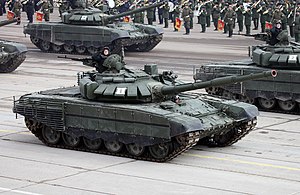T72
| T-72 | |
|---|---|

T-72B3 mod. 2016 (or B3M)
|
|
| Type | Main battle tank |
| Place of origin | Soviet Union |
| Service history | |
| In service | 1973–present |
| Used by | See Operators |
| Wars | See Combat History |
| Production history | |
| Designer | Leonid Kartsev-Valeri Venediktov |
| Designed | 1967–1973 |
| Manufacturer | Uralvagonzavod |
| Unit cost | US$0.5–1.2 million in 1994–1996, 30,962,000–61,924,000 rubles (US$1–2 million) in 2009 |
| Produced | 1973–present |
| No. built | 25,000+ |
| Specifications (T-72A) | |
| Weight |
|
| Length |
|
| Width | 3.59 m (11 ft 9 in) |
| Height | 2.23 m (7 ft 4 in) |
| Crew | 3 |
|
|
|
| Armour | Steel and composite armour |
|
Main
armament |
125 mm 2A46M/2A46M-5 smoothbore gun |
|
Secondary
armament |
|
| Engine | V-12 diesel V-92S2F (T-72B3 & T-72B3M)
|
| Power/weight | 18.8 hp/tonne (14 kW/tonne) |
| Transmission | Synchromesh, hydraulically assisted, with 7 forward and 1 reverse gears |
| Suspension | Torsion bar |
| Ground clearance | 0.49 m (19 in) |
| Fuel capacity | 1,200 L (320 U.S. gal; 260 imp gal) |
|
Operational
range |
460 km (290 mi), 700 km (430 mi) with fuel drums |
| Speed | 80 km/h (50 mph) |
|
|
|
|
|
The T-72 is a Soviet second-generation main battle tank that entered production in 1971. About 20,000 T-72 tanks were built, making it one of the most widely produced post–World War II tanks, second only to the T-54/55 family. The T-72 was widely exported and saw service in 40 countries and in numerous conflicts.
The development of the T-72 was a direct result of the introduction of the T-64 tank. The T-64 (Object 432) was a very ambitious project to build a competitive well-armoured tank with a weight of not more than 36 tons. Under the direction of Alexander Morozov in Kharkov a new design emerged with the hull reduced to the minimum size possible. To do this, the crew was reduced to three soldiers, removing the loader by introducing an automated loading system.
The much smaller design presented a problem when selecting a suitable engine. This led to the introduction of the 700 hp 5TDF engine, which was unreliable, difficult to repair, and had a guaranteed lifespan similar to World War 2 designs.
Production of the T-64 with a 115-mm gun began in 1964. Plans for an up-gunned T-64A with a more powerful 125-mm gun had already been made in 1963. Problems with the early production run were evident from the start, but a strong lobby formed around Morozov who advocated for the T-64 in Moscow, preventing rival developments and ideas to be discussed.
Because of the time-consuming construction of the 5TDF engines, which took about twice as long as the contemporary V-45, the Malyshev Factory in Kharkov could not provide a sufficient number of 5TDF engines for all Soviet tank factories. This led to efforts at Uralvagonzavod to design a version of the T-64 with the cheaper and much more reliable V-45 engine of 780 hp. This model was only to be serially produced in the event of a war, a so-called "mobilization model".
In 1967, the Uralvagonzavod formed "Section 520", which was to prepare the serial production of the T-64 for 1970. The team soon found out that the more powerful V-45 engine put a lot of stress on the T-64 hull, so that after some time cracks started to materialize. A more stable solution was sought.
...
Wikipedia
